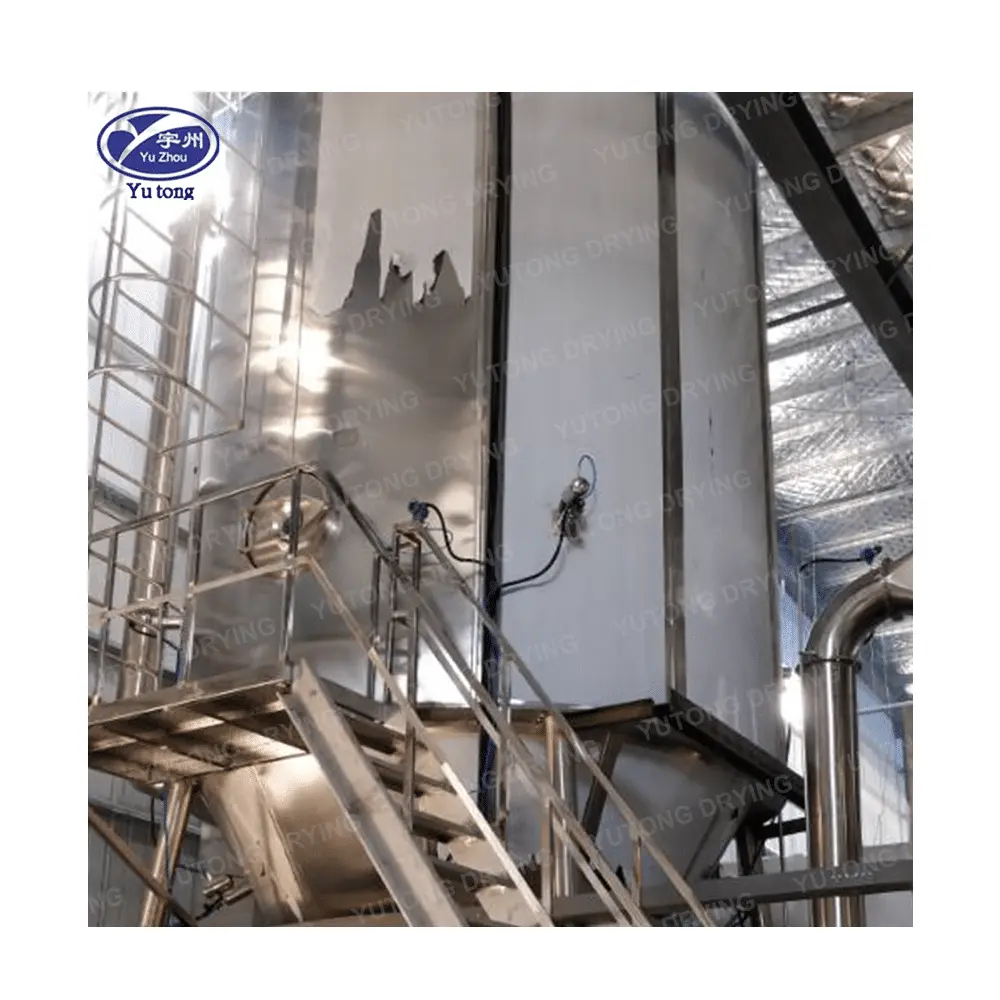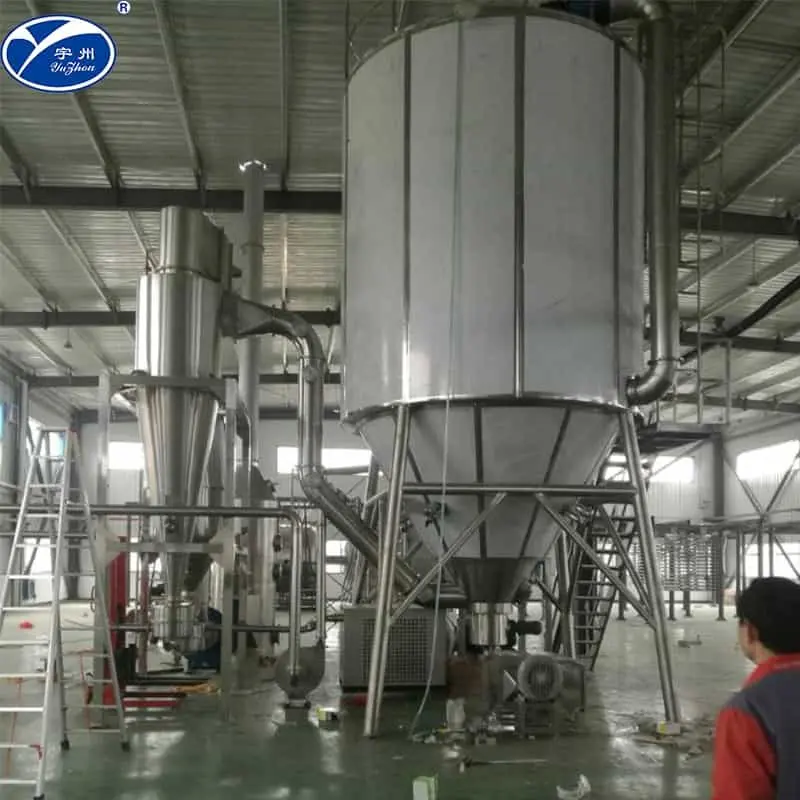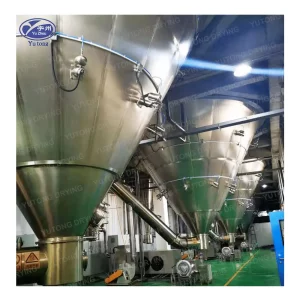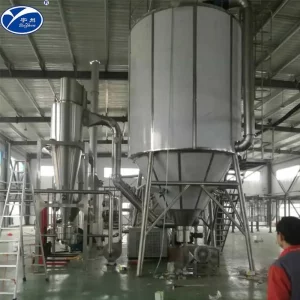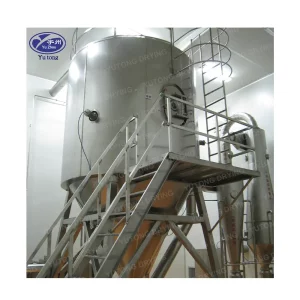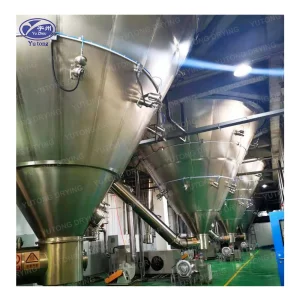Table of Contents
Product Detail
The world of spray drying is vast and intricate, offering numerous solutions for various industries. Denmark, in particular, is home to some of the most advanced spray-drying technologies and companies. This article delves into the spray drying process, highlights prominent Danish companies, and provides insights into the specifications and applications of spray dryers.
Understanding the Spray Drying Process
Spray drying is a method of producing a dry powder from a liquid or slurry by rapidly drying with a hot gas. This process is ideal for thermally sensitive materials such as foods and pharmaceuticals. It involves atomizing the liquid into a mist, where it is introduced into a hot drying chamber. The moisture quickly evaporates, leaving behind fine, dry particles.
The Atomization Process
Atomization is the first step in spray drying, where the liquid feed is broken down into fine droplets. This is achieved using various atomizers, such as rotary, nozzle, and ultrasonic, each offering distinct advantages. The choice of atomizer affects the droplet size distribution, which is crucial for determining the drying rate and final product quality. Consistent droplet size ensures uniform drying and optimal product consistency.
Drying Chamber Dynamics
Once the liquid is atomized, the droplets enter the drying chamber, where they are exposed to hot air. The design and configuration of the drying chamber play a vital role in the efficiency of the drying process. Factors such as airflow patterns, temperature distribution, and chamber geometry are meticulously engineered to optimize drying conditions. This ensures rapid moisture evaporation while preserving the integrity of sensitive materials.
Particle Collection and Separation
The cyclone separator is an essential component of the spray drying system, responsible for collecting the dried particles. It utilizes centrifugal force to separate particles from the drying air, ensuring that only dry powder exits the system. The efficiency of the cyclone separator is critical for maximizing yield and minimizing product loss. Advances in separator technology have led to improved collection efficiency, even for fine particles.
Exhaust and Environmental Control
The exhaust system plays a crucial role in maintaining the operational environment of the spray dryer. It removes excess air and vapor, preventing the buildup of pressure within the chamber. Additionally, modern exhaust systems incorporate environmental controls to minimize emissions and energy use. By managing airflow and temperature, these systems contribute to the overall efficiency and environmental sustainability of the spray drying process.
Leading Spray Dryer Companies in Denmark
Denmark is renowned for its innovative spray dryer manufacturers, with several companies leading the charge in design and technology.
Niro Spray Dryer Company
Niro is a well-established name in the spray drying industry, known for its reliable and efficient systems. Their spray dryers are widely used in various sectors, including pharmaceuticals, dairy, and food processing. Niro offers a range of models, from the lab-scale Niro Minor Spray Dryer to large industrial units.
Versatility Across Industries
Niro’s spray dryers are designed to meet the diverse needs of different industries. In the pharmaceutical sector, their systems ensure precise control over particle size and moisture content. In the dairy industry, Niro’s dryers are renowned for producing high-quality milk powders. Their adaptability to various applications is a testament to their engineering excellence.
Cutting-Edge Technology
Niro invests heavily in research and development to stay at the forefront of spray drying technology. Their commitment to innovation has led to the introduction of advanced features like automated control systems and energy-efficient designs. These advancements not only enhance product quality but also reduce operational costs and environmental impact.
Global Reach and Impact
With a strong international presence, Niro has established itself as a global leader in spray drying technology. Their systems are used in over 100 countries, reflecting their reputation for quality and reliability. By continually expanding its international footprint, Niro is instrumental in advancing spray drying capabilities worldwide.
Siccadania Spray Dryer
Siccadania provides customized solutions tailored to the specific needs of their clients. Their expertise in the design and manufacture of spray dryers ensures high performance and reliability. They focus on maximizing energy efficiency and product quality.
Customization and Flexibility
Siccadania prides itself on delivering bespoke solutions that cater to unique client requirements. Their flexibility in design and manufacturing allows them to address specific challenges faced by different industries. By working closely with clients, Siccadania develops systems that integrate seamlessly into existing production processes.
Energy Efficiency Innovations
One of Siccadania’s core strengths is its emphasis on energy efficiency. Their spray dryers incorporate features like heat recovery systems and optimized airflow designs to minimize energy consumption. These innovations not only reduce operational costs but also align with global sustainability goals.
Commitment to Quality Assurance
Quality assurance is at the heart of Siccadania’s operations. Their rigorous testing and validation processes ensure that every spray dryer meets the highest standards of performance and reliability. By maintaining stringent quality controls, Siccadania delivers systems that clients can trust for consistent and high-quality production.
GEA Process Engineering
GEA Process Engineering offers a comprehensive range of spray-drying equipment. They are known for their innovative solutions that cater to diverse applications, from small-scale laboratory setups to large-scale industrial systems.
Broad Range of Applications
GEA’s spray dryers are designed to handle a wide array of applications, from food and pharmaceuticals to chemicals and beyond. Their systems are versatile and capable of adapting to different product requirements and production scales. This adaptability makes them a preferred choice for companies seeking reliable and flexible drying solutions.
Focus on Innovation and Technology
Innovation is a driving force behind GEA’s success in the spray drying industry. They continuously invest in developing cutting-edge technologies that enhance system performance and efficiency. Features like real-time monitoring and advanced control systems are integral to their offerings, providing clients with superior operational control.
Global Expertise and Support
With a global network of experts and support centers, GEA is committed to delivering exceptional customer service. Their team of specialists provides comprehensive support, from initial consultation to installation and maintenance. This global reach ensures that clients receive timely and practical assistance, regardless of their location.
Applications of Spray Dryers
Spray dryers are versatile and used in numerous industries. Here are some typical applications:
Food Industry
In the food industry, spray dryers are used to produce milk powder, coffee, tea, and spices. The process helps retain flavor and nutrients while extending shelf life.
Nutrient Preservation
Spray drying in the food industry focuses on preserving essential nutrients and flavors. The rapid drying process minimizes thermal degradation, ensuring that the final product retains its nutritional value. This is particularly important for sensitive ingredients like vitamins and antioxidants.
Flavor Enhancement
In addition to nutrient preservation, spray drying enhances flavor profiles in food products. By carefully controlling the drying parameters, manufacturers can capture and concentrate natural flavors. This results in products with rich and authentic taste experiences.
Shelf Life Extension
One of the primary benefits of spray drying in the food industry is the extension of shelf life. By reducing moisture content, spray drying inhibits microbial growth, ensuring product stability. This allows food products to remain fresh and safe for extended periods, reducing waste and improving supply chain efficiency.
Pharmaceutical Industry
Spray drying is crucial in pharmaceuticals for creating powders used in tablets and capsules. It ensures precise dosage and enhances the stability of active ingredients.
Precision in Dosage
The pharmaceutical industry demands high precision in dosage formulations, and spray drying delivers on this requirement. The technology allows for the production of uniform particle sizes, ensuring consistent dosing in tablets and capsules. This is critical for maintaining therapeutic efficacy and patient safety.
Stability of Active Ingredients
Spray drying enhances the stability of active pharmaceutical ingredients (APIs) by creating a protective matrix around them. This matrix shields the APIs from environmental factors like moisture and heat, preserving their potency. As a result, spray drying is integral to the development of stable and effective pharmaceutical products.
Solubility Enhancement
Many pharmaceutical compounds suffer from poor water solubility, limiting their bioavailability. Spray drying offers a solution by transforming these compounds into amorphous forms, which are more soluble. This improves the absorption and effectiveness of the medication, benefiting patient outcomes.
Chemical Industry
In the chemical sector, spray dryers are used to produce catalysts, pigments, and detergents. The process allows for uniform particle size and consistency.
Uniform Particle Production
Uniform particle size is essential in the chemical industry for processes like catalysis and pigment dispersion. Spray drying ensures consistent particle formation, enhancing the performance and quality of chemical products. This uniformity is crucial for achieving desired chemical reactions and product characteristics.
Customizable Formulations
The chemical industry often requires customized formulations to meet specific application needs. Spray drying provides the flexibility to tailor particle size, shape, and composition. This customization capability allows manufacturers to develop specialized products for niche markets and applications.
Environmental and Safety Considerations
Spray drying in the chemical industry incorporates safety and environmental considerations into its design. The enclosed systems minimize exposure to hazardous materials, ensuring worker safety. Additionally, modern spray dryers are engineered to reduce emissions and energy consumption, aligning with environmental regulations and sustainability goals.
Spray Dryer Specifications
When selecting a spray dryer, understanding its specifications is vital. Key parameters include:
Capacity and Throughput
The capacity of a spray dryer determines the volume of liquid that can be processed. This is a critical factor for manufacturers aiming to meet production demands. High-capacity dryers are designed for large-scale operations, while smaller units cater to laboratory or pilot-scale production. Understanding capacity needs ensures efficient resource utilization and cost management.
Temperature Control and Range
The temperature range of a spray dryer affects the drying speed and quality of the final product. Precise temperature control is essential for preserving the properties of thermally sensitive materials. Advanced systems offer dynamic temperature adjustments, accommodating variations in feedstock and process requirements.
Atomization Techniques
Different atomization methods, including rotary, nozzle, and ultrasonic, are available to suit various applications. Each technique offers distinct advantages in terms of droplet size distribution and energy efficiency. Selecting the appropriate atomization method is crucial for optimizing drying performance and achieving desired product characteristics.
Material Construction and Compatibility
The construction materials of a spray dryer must be compatible with the product being dried. Stainless steel is commonly used for its durability and resistance to corrosion. For highly reactive or sensitive materials, specialized coatings or materials may be required. Ensuring material compatibility prevents contamination and maintains product integrity.
Innovations in Spray Drying Technology
The spray drying industry continues to evolve, with companies investing in research and development to enhance efficiency and sustainability.
Energy Efficiency
Modern spray dryers are designed to minimize energy consumption. Innovations such as heat recovery systems and improved insulation contribute to reduced operational costs and environmental impact.
Heat Recovery Systems
Heat recovery systems capture and reuse waste heat generated during the drying process. By recycling this energy, spray dryers reduce their overall energy consumption. This not only lowers operational costs but also decreases the carbon footprint of the drying process.
Advanced Insulation Techniques
Insulation plays a crucial role in maintaining temperature stability within the drying chamber. Advanced insulation materials and techniques minimize heat loss, enhancing energy efficiency. By optimizing thermal management, spray dryers achieve consistent performance with reduced energy input.
Renewable Energy Integration
As sustainability becomes a priority, integrating renewable energy sources into spray drying operations is gaining traction. Solar panels and wind turbines are increasingly being used to power spray dryers, reducing reliance on fossil fuels. This shift towards renewable energy aligns with global efforts to combat climate change.
CIP (Clean-In-Place) Systems
CIP systems are becoming increasingly popular, allowing for automated cleaning of spray dryers without disassembly. This feature is crucial for maintaining hygiene and reducing downtime, especially in the food and pharmaceutical industries.
Automation and Efficiency
Automated CIP systems streamline the cleaning process, reducing the need for manual intervention. This automation minimizes downtime and increases operational efficiency. By integrating CIP systems, manufacturers can maintain high hygiene standards while maximizing production uptime.
Hygiene and Contamination Control
Maintaining hygiene is paramount in industries like food and pharmaceuticals. CIP systems ensure thorough cleaning of all spray dryer components, preventing contamination. This is essential for compliance with regulatory standards and for ensuring the safety and quality of the final product.
Cost and Resource Savings
CIP systems offer significant cost savings by reducing the labor and resources required for cleaning. The automated process uses precise amounts of cleaning agents and water, minimizing waste. This efficiency translates into lower operational costs and a smaller environmental footprint.
Advanced Control Systems
State-of-the-art control systems offer real-time monitoring and automation, ensuring optimal performance and consistency. These systems allow for precise adjustments to the drying process, accommodating changes in feedstock or product requirements.
Real-Time Monitoring and Feedback
Advanced control systems provide real-time data on key process parameters, enabling operators to make informed decisions. This continuous feedback loop ensures that the drying process remains within optimal conditions, enhancing product quality and consistency.
Process Automation and Optimization
Automation capabilities within control systems streamline operations, reducing the need for manual adjustments. By optimizing process parameters automatically, these systems enhance efficiency and reduce the risk of human error. This leads to more reliable and predictable production outcomes.
Data-Driven Insights and Analysis
Control systems equipped with data analytics tools offer valuable insights into the spray drying process. By analyzing historical and real-time data, manufacturers can identify trends and areas for improvement. This data-driven approach facilitates continuous optimization and innovation in spray drying technology.
Conclusion
Denmark’s contributions to the spray drying industry are significant, with companies like Niro, Siccadania, and GEA leading the way. Their advancements in technology and design have set new standards for efficiency and quality.
Whether you’re in the food, pharmaceutical, or chemical industry, understanding the capabilities and specifications of spray dryers is essential for optimizing production processes. As technology continues to advance, spray dryers will undoubtedly become even more integral to various manufacturing sectors.
In exploring the world of spray drying in Denmark, it’s clear that innovation and expertise drive the industry forward, offering reliable and efficient solutions for diverse applications. With a focus on sustainability and advanced technology, the future of spray drying looks promising, poised to meet the evolving needs of global industries.
Specifications
|
spec
|
ZPG-25
|
ZPG-50
|
ZPG-80
|
ZPG-100
|
ZPG-150
|
ZPG-200
|
ZPG-300
|
|
|
evaporation capacity(kg/h)
|
25
|
50
|
80
|
100
|
150
|
200
|
300
|
|
|
process amount of material liquid(kg/h)
|
25-34
|
50-68
|
80-108
|
100-135
|
150-203
|
200-270
|
300-406
|
|
|
output of finished pcoduct(kg/h)
|
4.8-7.2
|
9.2-14
|
14.8-22.4
|
18.4-28
|
24-42
|
36.8-56.4
|
55-85
|
|
|
solid content of material liquid( %)
|
18-30
|
|||||||
|
moisture content of finished product( %)
|
3-5
|
|||||||
|
electric power(kw)
|
63
|
132
|
153
|
204
|
246
|
330
|
||
|
heat source
|
Steam pius electricity
|
|||||||
|
Collecting method of product and its efficiency
|
Grade one or two or three stage cyclone wet dust remover is greater than or equal to 95%
|
|||||||
|
automatic control meters and instruments
|
indicator of not air and exhaust air temperature
|
|||||||
|
temperature of air inlet(℃)
|
160-220
|
|||||||
|
temperature of air outlet(℃)
|
80-100
|
|||||||
|
L
|
7000
|
8000
|
9800
|
11000
|
12200
|
14100
|
15000
|
|
|
overal dimensions(mm)
|
W
|
4000
|
5000
|
5700
|
6200
|
7000
|
7800
|
9000
|
|
H
|
6200
|
6900
|
8000
|
8900
|
10750
|
11900
|
13000
|
|
Applications
Machinery Repair Shops: Can be used for drying lubricants, cleaning agents, or other liquid substances related to machinery maintenance and repair.
Food & Beverage Factory: Ideal for drying food ingredients like milk powder, fruit and vegetable powders, flavourings, etc., thanks to its hygienic construction and precise drying control.
Farms: Useful for drying agricultural products or by-products in certain processing scenarios.
Retail and Food Shop: May be employed for small-scale drying operations or demonstrations related to food products.
Construction works: Can handle the drying of certain construction materials or chemical admixtures.
Energy & Mining: Applicable for drying chemical reagents or samples in related processes.
Food & Beverage Shops: Similar to food factories, it can be used for in-shop drying of food items or custom blends.
Our industrial spray dryer is a versatile and reliable asset for multiple industries, offering efficient drying, long service life, and user-friendly operation. It is engineered to meet the highest standards of quality and performance, making it an ideal choice for any industrial drying application.

